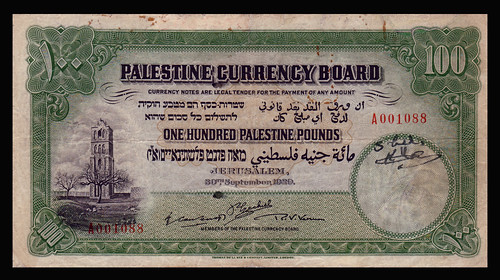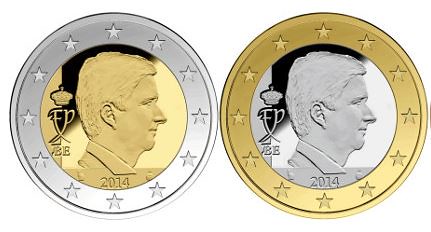
PREV ARTICLE
NEXT ARTICLE
FULL ISSUE
PREV FULL ISSUE
NOTES FROM E-SYLUM READERS: FEBRUARY 23, 2014Ruth Hill Not a Founding IBNS Member Ron Richardson Editor, IBNS Journal writes: In response to my colleague Howard Daniel's "correction" to my comment that Ruth Hill was not a founding member of the International Bank Note Society, I would have to point him to the IBNS Journal Vol 50: No 4 of 2011 which has a full listing of the Charter members of IBNS. However, I acknowledge his reference to another copy of the Journal that notes Mrs. Hill was a founding member. That reference is incorrect. I say that with some embarrassment as I was editor of that issue of the Journal and also on the Awards Committee and likely wrote the incorrect reference myself. Everything else Howard writes on the huge contribution Mrs Hill made to paper money collecting I strongly endorse. To read the earlier E-Sylum article, see: MORE ON RUTH HILL (www.coinbooks.org/esylum_v17n07a13.html) The Antiquities of the Jews In last week's review of Coins of the Bible I wrote: ... direct quotations of Bible passages mentioning or referring to coins, such as: "And when Moses had gathered the multitude together again, he ordained that they should offer half a shekel for every man, as an oblation to God; which shekel is a piece among the Hebrews, and is equal to four Athenian drachmae, (Antiquities 3.8.2)" François R. Velde writes: That's not a direct quotation of the Bible. "drachma" is a sure sign that the quote isn't biblical - it's too late for the Old Testament and too early for the New one My mistake. I wasn't the most attentive Sunday School student, but I didn't recognize " Antiquities" as a book from the Bible, but was in too much of a rush to question it. The book's quotes are not all from the Bible as I stated. This one is from a work by Flavius Josephus titled "The Antiquities of the Jews". To read the Flavius Josephus book, see: Antiquities of the Jews by Flavius Josephus (www.gutenberg.org/ebooks/2848?msg=welcome_stranger#link32HCH0008) Publisher Dennis Tucker adds: Money of the Bible, 3rd edition, has been written up for ProtoView (formerly Book News, Inc.’s “Reference & Research Book News”). Their title entries are sent to discovery services that license their content, including Ex Libris: "This third edition is further updated with more pictures and more anecdotes. Bressett has been involved with numismatics since the 1940s, and this book is a lovingly prepared, abundantly illustrated compendium about money in the ancient world." It’s always nice to see a numismatic book get some coverage outside our rarefied sphere! To read the earlier E-Sylum article, see: BOOK REVIEW: MONEY OF THE BIBLE, 3RD EDITION (www.coinbooks.org/esylum_v17n07a06.html) Palestinian £100 Banknote Image Copyright Howard Berlin writes: I was surprised to see the picture of the 1929 £P100 note (S/N A001088) issued during the British Mandate of Palestine in the recent issue of The E-Sylum (v17#07 February 16, 2014). It so happens that I was the former owner of this note, of which there are only four known (that are not specimens or color trials). It was the crowning jewel of my collection of Palestine coins and notes that I had collected for over 20 years. I had sold my whole collection back in 2001 after exhibiting various part of it at national, regional and local shows and was fortunate to have won a few best of show awards. This notes appears both on the paperback cover and as a featured color plate of my book, The Coins and Banknotes of Palestine Under the British Mandate, 1927–1947, which is also copyrighted. The image of this note has long been on my copyrighted webpage about the coins and banknotes of the Palestine Mandate since 1999. What irritates me is that an individual using the Wikipedia ID of Arabmuslim12 has literally stolen this image and placed it on the Hebrew-language Wikipedia site and has the chutzpah to claim that he/she is the author of this work! This thief has indicated that this file is licensed under the Creative Commons Attribution - Share Alike 3.0 Unported, 2.5 Generic, 2.0 Generic and 1.0 Generic license. In the past I have graciously allowed individuals to use this image for educational purposes when asked as long as the source is acknowledged. An "official" image, which much better view of this note is attached. I now have find out how to have this Wikipedia page deleted or have the proper attribution made.

Image Copyright (c) Dr. Howard M. Berlin To read the earlier E-Sylum article, see: OSAMA BIN LADEN BANKNOTE (www.coinbooks.org/esylum_v17n07a25.html) 2014 Belgium Coin Sizes Last week I wrote: "I like the switcheroo of the two metals in this bimetallic design. Are these the same or different denominations? Despite the clear difference, these could get confusing if they're not the same denomination."

Pabitra Saha writes: The first one or the one with Copper Nickel ring, is 2 Euro whereas the second one is one euro. The actual coins are different sized. Denomination: 1 Euro; Composition: Bi-metallic Copper-Nickel Centre in Nickel-Brass Ring; Diameter: 23.25 mm; Weight: 7.5 g; Edge: Segmented Reeding Denomination: 2 Euro; Composition: Bi-metallic Nickel-Brass Centre in Copper-Nickel Ring; Diameter: 25.75 mm; Weight: 8.5 g; Edge: Lettered with legend
Thanks! E-Sylum illustrations are notoriously uniform in size, making is difficult to tell the relative sizes of coins. That's what full-time editors of real publications get paid to do. I slap in whatever looks good and move on.
-Editor
To read the earlier E-Sylum article, see: SOME NEW COIN DESIGNS: FEBRUARY 16, 2014 (www.coinbooks.org/esylum_v17n07a20.html) 1882-CC dollar Variety Correction Steve Bishop writes: One small correction to Tom Kays' Numismatic diary, which I should have picked up in the preview copy you sent: The 1882-CC dollar was a VAM 2C, not 2A, the difference being that the 2C is a later die state and scarcer, particularly in a GSA holder. To read the earlier E-Sylum article, see: TOM KAYS' NUMISMATIC DIARY: FEBRUARY 16, 2014 (www.coinbooks.org/esylum_v17n07a16.html) Treating Book Leather Alan Weinberg writes: I've got an approx. 10" x 10" x 1 1/2" US Mint-made leather presentation case for my Dr Frederick Rose 1858 Buchanan portrait Congressional Gold Medal. It is bright red leather in quite nice condition with gold-embossed US mint images- Indian Head, Seated Liberty, eagles, etc. To prevent the leather from drying out or becoming brittle, I'd like to treat the leather with an oil or cream to keep it soft and supple. When I was a kid, we used to use "Neetsfoot Oil" for our leather baseball gloves. But that was 60 years ago. What did Armand Champa or John Ford use to preserve or bring back to life old leather book bindings? What would you recommend or use? Keep in mind the leather has numerous gilt raised images which I don't want to darken...that may be a factor.
Well, I'm not sure, but this would be a great E-Sylum topic. What do our readers recommend?
-Editor
Wayne Homren, Editor The Numismatic Bibliomania Society is a non-profit organization promoting numismatic literature. See our web site at coinbooks.org. To submit items for publication in The E-Sylum, write to the Editor at this address: whomren@gmail.com To subscribe go to: https://my.binhost.com/lists/listinfo/esylum All Rights Reserved. NBS Home Page Contact the NBS webmaster 
|